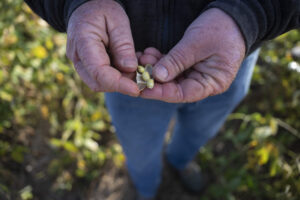US soybean farmers are facing significant challenges due to the ongoing trade row with China. The world’s second-largest economy, which purchased over half of the $24.5 billion in US soybean exports in 2024, has halted orders, leading to a substantial decline in exports. According to the American Soybean Association (ASA), exports to China have fallen by over 50 percent in value this year, with Chinese buyers holding off on new soybean orders from the US autumn harvest.
The trade dispute, triggered by President Donald Trump’s aggressive tariffs, has resulted in lower demand and subsequently lower soybean prices, which are down about 40 percent from three years ago. This comes as American soybeans have become pricier for Chinese buyers due to the 20 percent counter-duties imposed by Beijing. The ASA notes that this makes US soybeans “prohibitively more expensive” than exports from South America, where US farmers face growing competition.
Farmers like Travis Hutchison, who tills 3,400 acres of soybeans, corn, and other crops in rural Maryland, are feeling the effects of the trade war. Hutchison acknowledges that while he initially supported President Trump’s efforts to secure better trade deals, he is disappointed that the situation has not been resolved sooner. The ASA president, Caleb Ragland, expressed similar sentiments, stating that the latest developments are “deeply disappointing” at a time when soybean farmers are facing a growing financial crisis.
The situation is especially harsh in Midwestern states like North and South Dakota, where the soybean industry is built around exporting to the Pacific Northwest and subsequently to China. Farmers in these regions are hard-hit if they run out of storage and cannot ship their harvests. According to ASA chief economist Scott Gerlt, farmers have it harder than in 2018, when they were also caught in Washington and Beijing’s tariff war, due to lower crop revenues and higher costs for everything from fertilizers to equipment.
The US government has promised to provide support to farmers affected by the trade disputes, but a long-term solution is still needed. As Hutchison noted, a government bailout is a “band-aid” rather than a permanent fix. With time running out, as China’s soybean purchasing window from the United States usually runs from October through January, farmers are urging for a resolution to the trade dispute. The surge in US farm bankruptcies, which has increased by about 50 percent from 2024, according to Professor Chad Hart of Iowa State University, highlights the urgency of the situation.
